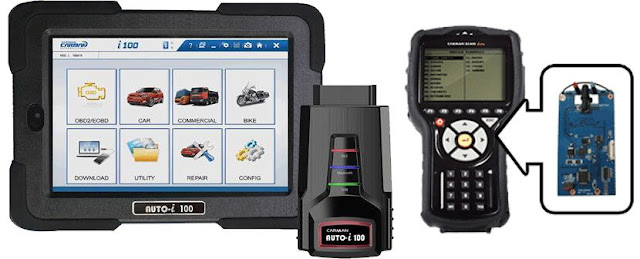An automotive diagnostic scan tool is a very useful equipment for DIY car owners. It can interpret error codes sent by different systems in a vehicle such as engine management system, transmission system, ignition system, entertainment system, etc. Some advanced tools can even send coded messages to these systems and program them. You can diagnose issues involving different systems of the vehicle with the help of these tools. Once the problem is known, it is up to your capabilities, whether you want to take it to a garage or sort out the matter yourself.
In-built diagnostic module
Vehicles come with a standard on board diagnostic module, which is a computer known as OBD-II. This computer is connected to all the systems of the vehicle with the help of sensors. Data on various performance criteria of various system components is fed them into this computer automatically. The inputs are analyzed by the computer which then sends commands to the concerned system to start, stop or fine tune its performance. However, when a system is malfunctioning, the sensor attached to it sends coded messages to the computer. Different error codes translate to different types of malfunction, but you need a device to interpret the codes and diagnose the problem. It is here that an automotive diagnostic scan tool comes handy. To use this tool you have to connect it to the OBD-II to read and interpret the data.
Different brands of scan tool
The market is flush with different brands of automotive scan tools with varying degrees of performance and abilities. Carman and Launch are two reputed brands of scan tool. Let us compare their performances and decide for yourself which is best for your vehicle.
Automotive diagnostic scan tool – Carman Vs Launch Scanner
Carman scan tools
In-built diagnostic module
Vehicles come with a standard on board diagnostic module, which is a computer known as OBD-II. This computer is connected to all the systems of the vehicle with the help of sensors. Data on various performance criteria of various system components is fed them into this computer automatically. The inputs are analyzed by the computer which then sends commands to the concerned system to start, stop or fine tune its performance. However, when a system is malfunctioning, the sensor attached to it sends coded messages to the computer. Different error codes translate to different types of malfunction, but you need a device to interpret the codes and diagnose the problem. It is here that an automotive diagnostic scan tool comes handy. To use this tool you have to connect it to the OBD-II to read and interpret the data.
Different brands of scan tool
The market is flush with different brands of automotive scan tools with varying degrees of performance and abilities. Carman and Launch are two reputed brands of scan tool. Let us compare their performances and decide for yourself which is best for your vehicle.
Automotive diagnostic scan tool – Carman Vs Launch Scanner
Carman scan tools
It is a stand-alone device with a touchpad and can be used as an adapter for your PC. There are a number of models suitable for different brands of vehicles.
Supported functions
It supports functions such as DTC reading, analysis and erasing, current data view in both graphic and parameters mode, activation function, manual parameter grouping, system identification, flight record, service resetting, sensor calibration, programming of remotes, keys, injector and other components. It also supports some special functions such as coding for Injector. The tool runs on Windows 10, and you can print via Wi-Fi. You can also make use of the USB port. The best thing is that you can get frequent updates of the firmware that will enhance the performance of the tool.
The product is compatible with most of the electronic systems in vogue like ENG, ENG-2, EA, AIRBAG/ETR (SRS), CCS, ADS, BM/GM, IMMO, ASD, A/C, RB, AHLS, RST, EPS, ECS, FWDS, AC, FFH, KCS etc.
Coverage by vehicle brand
The tool is also compatible with most of the vehicle brands such as Honda, Toyota, Mitsubishi, Lexus, Subaru, Nissan, Suzuki, Mazda, Mercedes Benz, Isuzu, Hyundai, Daewoo, BMW, Skoda, Volkswagen, Volvo, Opel, Ford, Fiat, Peugeot, General Motors etc.
Launch Scan Tools
Launch scan tools help the users perform OEM level diagnosis of vehicles.
Supported Functions
The scanner supports full OBDII test mode coverage, module programming, key programming, air bag system functions, auto transmission functions, relearn procedures etc.
Vehicle Coverage
The vehicle coverage of Launch scanner is awesome. It supports a range of large vehicles like trucks from Ashok Leyland, MAN, Volvo etc apart from the large number of cars. In fact ,it is compatible with at least 34 truck brands. The scanners are custom built for different brands of vehicles. This is why you can read manufacturer specific error codes by using Launch scan tools. The products undergo continuous upgrades so that support is continuous and more and more functions are covered by it. The Products are categorized into different series ,some of which are specifically designed for trucks.
Electronic Systems And Circuits
It supports almost all electronic systems and circuits presently installed in vehicles. Moreover, you can get free software updates year after year.
Conclusion
Automotive diagnostic scan tools are primarily code readers with advanced capabilities. Functionalities increase in range or change with price and brand. But if you are a DIY car owner you need to think about your knowledge of car repair. Going overboard on purchasing a high definition automotive scan tool may be futile if you are not able to sort out the problem yourself.











